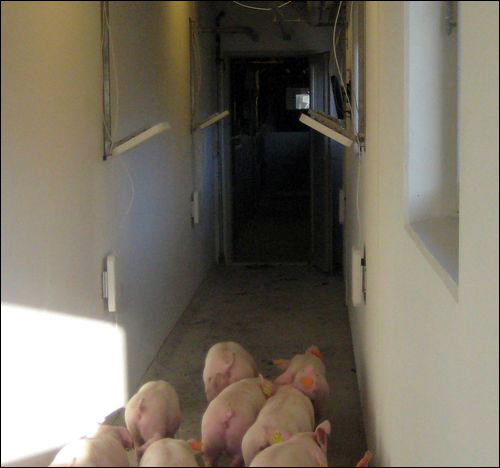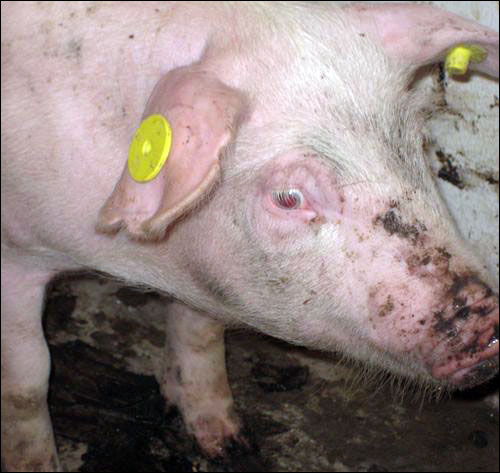Jan 19, 2012The Danish Agriculture & Food Council's Pig Research Center is reviewing the results of a three-year pilot that tested ultrahigh-frequency (UHF) RFID technology to track pigs from a few weeks after they are born until they are sold or received at a slaughterhouse. The project, known as PigTracker, included five Danish pig breeders, with up to 3,000 animals receiving RFID ear tags at each location. The PigTracker pilot, according to Niels Peter Baadsgaard, a veterinarian serving as the research center's chief scientist for veterinary research and development, found that UHF technology read tags at a higher rate than was achieved using low-frequency (LF) tags (the type of RFID technology more commonly utilized for animal tracking), and was also less expensive. The project was funded by the Danish Ministry of Food, Agriculture and Fisheries.
During the pilot, the UHF tags worn by the pigs were read from a distance of 2 meters (6.6 feet) at a 100 percent read rate, while farmers who have used LF technology, Baadsgaard reports, find that LF tags can only be read from approximately 20 centimeters (7.9 inches), and thus require individually reading each pig's tag. As a herd of swine moves from one location to another, it can be time-consuming to read every tag, and tags can sometimes be missed when farm workers try to read each tag individually at short range.

Currently, most cattle in Denmark wear LF tags, as is required by federal mandates, and while farmers are not required to track their pigs electronically, many have also tried the LF tags in order to improve their visibility into each pig's whereabouts, and to provide an automated record of every animal's history and medical treatments or vaccinations. However, due to the shortcomings of LF RFID technology, Baadsgaard and his colleagues launched a pilot aimed at determining whether UHF was a viable alternative. The researchers contacted several companies that provide UHF RFID solutions for the agricultural industry, and asked them to develop a UHF system for testing.
"It is well-known that water and body tissues reduce the performance of UHF RFID," Baadsgaard says. Therefore, Danish RFID firms RF-LabelTech and Br-Technic designed and developed an EPC Gen 2 passive UHF RFID transponder that could be read in the presence of body tissue. The transponder was then incorporated into custom-built ear tags provided by TraceCompany. Another RFID firm, Prosign RFID, tested multiple interrogators before selecting handheld readers from Psion and Nordic ID that were able to read the tags most consistently at the greatest range. The company also installed fixed Impinj Speedway R420 Revolution interrogators, each with four antennas, at portals through which pigs passed.
The system was tested on individual herds at five different breeder locations, as well as at a single slaughterhouse, all located in Denmark. Initially, Baadsgaard says, the project involved developing the use case for RFID readings based on farmers' needs. "We worked in close collaboration with the end users," he explains, "to get an idea of how this would work in a normal daily routine." The herds consisted of 2,000 to 3,000 pigs apiece, with each animal receiving a TraceCompany RFID tag attached to its ear at the age of three to four weeks. An EPC data standard was chosen for the tag's ID number, and the ID was associated with that specific pig in the Internet-based software developed by the Pig Research Center. Once the tag was attached, farmers could then input data about that animal, such as its date of birth and weight.
Each farm was equipped with several fixed Impinj readers—some utilized two portals, while others used three. In each case, the fixed readers and antennas were mounted on ceilings or walls in the hallways through which pigs pass while moving from one area to another, such as from the farrowing unit (birthing area) to the weaning unit, or out of the facility to be sent to the slaughterhouse. Every time that a pig passed under the antenna, its tag ID was read, and that information was transmitted via a wired connection to the back-end software, where the tag ID was linked to the event: the pig's movement from one unit to another, along with its health and historical details.
At the slaughterhouse, an RFID interrogator was mounted above the receiving doorway, in order to capture tag ID numbers as the pigs entered the facility, in an effort to link a specific swine to a particular carcass, and the meat coming from that carcass. However, Baadsgaard notes, this process still requires more development, since the slaughterhouse's busy environment poses challenges for the reading process.

According to Baadsgaard, the project found that the UHF tags' longer read ranges—up to 2 meters (6.6 feet) with fixed readers and 80 centimeters (31.6 inches) using a handheld device—make it easier to track animals that move quickly in multiple directions. "These read ranges apply for small ear tags [30 millimeters in diameter] for small piglets," Baadsgaard says. "Larger tags will have larger antennas and, therefore, higher read rates and read ranges, as well." Unlike LF tags, however, the UHF tags can be rendered ineffective if the tags become extremely dirty. "If we had normally clean pigs," he says, "we had close to 100 percent read rate."
Baadsgaard is still reviewing the full results, and within the next few months, he plans to summarize them in a report posted on the PigTracker Web site. In the meantime, the TraceCompany RFID ear tags are for sale to pig farmers, though they have not yet been produced in high volume. Two companies, Agrosoft and DLBR, have taken over the task of further developing the PigTracker software, which farmers can purchase to track their animals, and eventually share data via the Internet with other farmers or buyers.
Baadsgaard says the system will supply farmers with an answer to the basic question, "Where is my pig?" and indicate where a specific animal comes from, its age and if it has been treated medically. He suspects that many farmers will adopt the technology, including several who participated in the pilot. "Given the experiences from the pilot," he states, "it's conceivable that RFID applications may come in place within other areas of farming as an asset-management tool."


